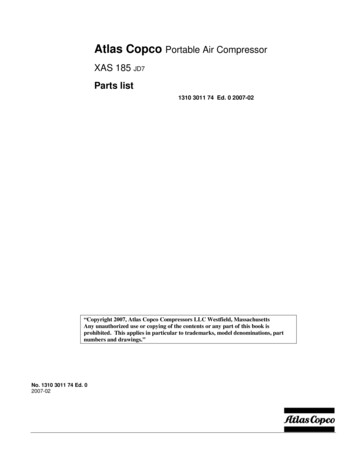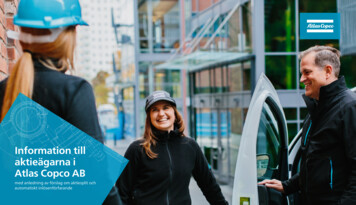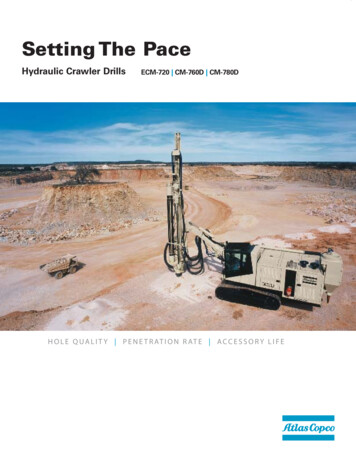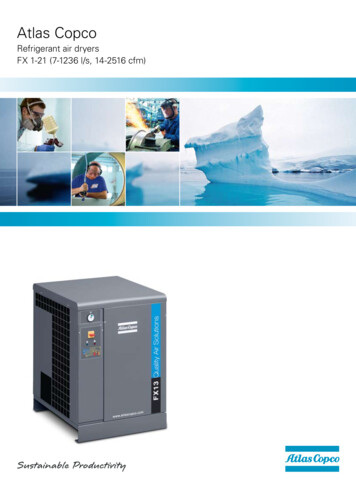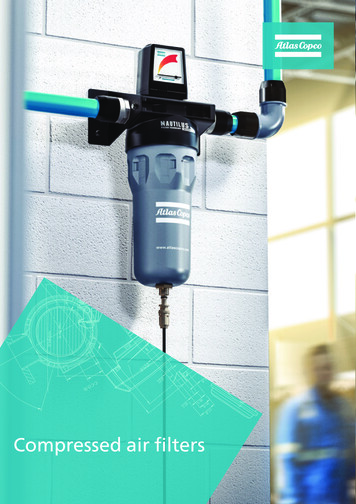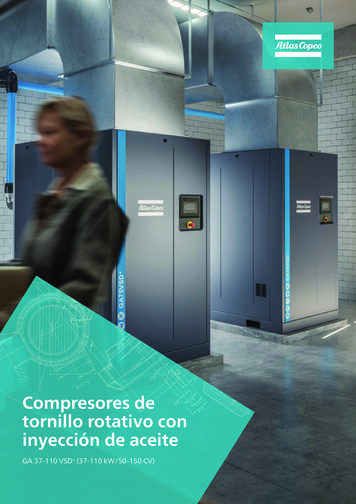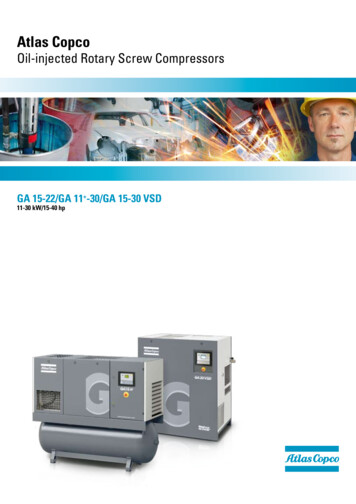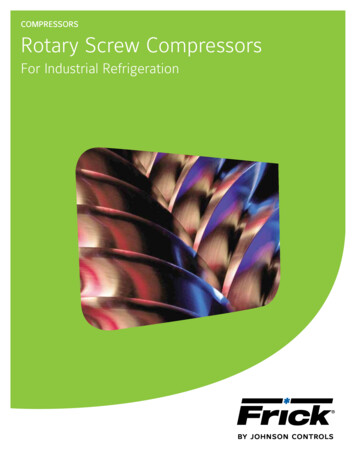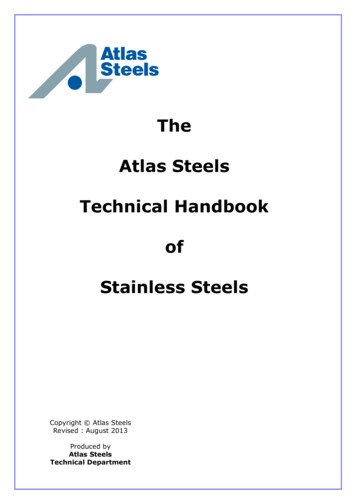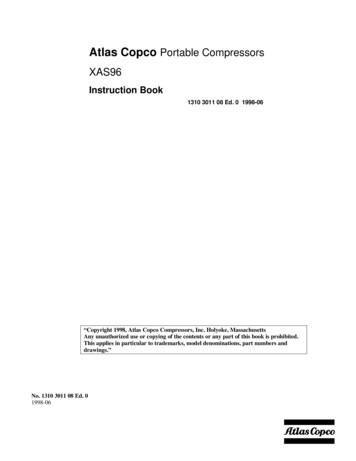
Transcription
Atlas Copco Portable CompressorsXAS96Instruction Book1310 3011 08 Ed. 0 1998-06“Copyright 1998, Atlas Copco Compressors, Inc. Holyoke, MassachusettsAny unauthorized use or copying of the contents or any part of this book is prohibited.This applies in particular to trademarks, model denominations, part numbers anddrawings.”No. 1310 3011 08 Ed. 01998-06
OWNERSHIP DATAUnit model:Owner's machine no.:Engine type:Unit service no.:Delivery date:Engine serial no.:Service plan:First start-up date:Selected LubricantsCompressor:Capacity:Bearing grease type, electric motor:Printed Matter Nos.Atlas Copco instruction book / rev:Atlas Copco logbook:Atlas Copco parts list / rev:Engine parts list:Local Atlas Copco act persons:Service:Parts:1310 3011 08
Table of Contents1 Safety Precautions for Portable Compressors. 41.11.21.31.41.51.61.71.81.91.102Leading Particulars. 102.12.22.32.42.52.62.73Adjustment of the Continuous Regulating System . 22Air Filter Engine/Compressor . 23Air Receiver . 23Safety Valve . 23Fuel System. 24Problem Solving. 256.16.27Use of Service Paks . 18Preventive Maintenance Schedule For The Compressor. 18Lubrication oils. 19Oil Level Check. 19Oil And Oil Filter Change. 20Cleaning Coolers . 20Battery Care . 20Storage . 21Service Kits . 21Adjustments and Servicing Procedures. 225.15.25.35.45.56Parking, Towing And Lifting Instructions . 16Before Starting . 16Starting/Stopping. 17During Operation. 17Maintenance. 184.14.24.34.44.54.64.74.84.95Description of Safety Pictograms Used in this Manual. 10General Description . 10Main Parts . 11Air Flow (See Fig. 2.3) . 12Oil system (see Fig. 2.3) . 13Continuous regulating system (see Fig. 2.3) . 13Electrical System . 14Operating Instructions . 163.13.23.33.44Introduction.4General Safety Precautions .4Safety during use and operation .5Safety During Maintenance and Repair .6Tool Applications Safety.7Batteries .7Ether fuel Systems .7Pressure vessels .8Safety valve .8Injury Prevention .8Problem Solving Chart. 25Alternator Precautions . 25Principal Data. 281310 3011 083
1Safety Precautions for Portable CompressorsTo be read attentively and acted accordingly before towing, lifting, operating,performing maintenance or repairing the compressor1.1Introduction2Use only lubricating oils and greases recommended orapproved by Atlas Copco or the machine manufacturer.Ascertain that the selected lubricants comply with allapplicable safety regulations, especially with regard toexplosion or fire risk and the possibility of decomposition orgeneration of hazardous gases.3Before handling any product, take time to read therelevant instruction book. Besides giving detailedoperating instructions, it also gives specific informationabout safety, preventive maintenance, etc.The supervisor, or the responsible person, shall at all timesmake sure that all instructions regarding machinery andequipment operation and maintenance are strictly followedand that the machines with all accessories and safety devices,including the entire compression or vacuum system withpipes, valves, connectors, hoses, etc., as well as theconsuming devices, are in good repair, free of abnormal wearor abuse, and are not tampered with.4These precautions are general and some statements willtherefore not always apply to a particular unit.Maintenance, overhaul and repair work shall only be carriedout by adequately trained personnel; if required, undersupervision of someone qualified for the job.5Whenever there is an indication or any suspicion that aninternal part of a machine is overheated, the machine shall bestopped. No inspection covers shall be opened beforesufficient cooling time has elapsed; this is to avoid the risk ofspontaneous ignition of the oil vapor when air is admitted.6Maintenance work, other than routine attention, shall only beundertaken when the machine is standing still.7Before dismantling any pressurized component, thecompressor or the equipment shall be effectively isolatedfrorn all sources of pressure and be completely vented toatmosphere. In addition, a warning sign bearing a legend suchas "work in progress; do not open" shall be attached to each ofthe isolating valves.8Before a machine is being repaired, steps shall be taken toprevent inadvertent starting. In addition, a warning signbearing a legend such as "work in progress; do not start" shallbe attached to the starting equipment. The battery shall bedisconnected and removed or the terminals covered byinsulating caps.9Normal ratings (pressures, temperatures, speeds, etc.) shall bedurably marked.The policy of Atlas Copco is to provide the users of theirequipment with safe, reliable and efficient products.Factors taken into account are among others:- the intended and predictable future use of theproducts, and the environments in which they areexpected to operate,- applicable rules, codes and regulations,- the expected useful product life, assuming properservice and maintenance.When handling, operating, overhauling and/or performingmaintenance or repair on Atlas Copco equipment, themechanics are expected to use safe engineering practicesand to observe all relevant local safety requirements andordinances. The following list is a reminder of specialsafety directives and precautions mainly applicable toAtlas Copco equipment.This brochure applies to machinery processing orconsuming air or inert gas. Processing of any other gasrequires additional safety precaution typical to theapplication and are not included herein.All responsibility for any damage or injury resulting fromneglecting these precaution: or by non-observance ofordinary caution and due care required in handling,operating, maintenance or repair, also if not expresslymentioned in this brochure or the instruction book(s), isdisclaimed by Atlas Copco.If any statement does not comply with local legislation,the stricter of the two shall be applied. Statements in thismanual should not be interpreted as suggestions:,recommendations or inducements that it should be used inviolation of any applicable laws or regulations.1.21General Safety PrecautionsThe owner is responsible for maintaining the unit in asafe operating condition. Unit parts and accessoriesmust be replaced if missing or unsuitable for safeoperation.10 Never operate a machine or equipment beyond its rated limits(pressure, temperature, speed, etc.).11 Maintenance and repair work should be recorded in anoperators logbook for all machinery. Frequency and nature ofrepairs can reveal unsafe conditions.12 The machinery and pneumatic equipment shall be kept clean,i.e. as free as possible from oil, dust or other deposits.13 To prevent an increase in working temperature, inspect andclean heat transfer surfaces (cooler fins, intercoolers, waterjackets, etc.) regularly. For every machine establish a suitabletime interval for cleaning operations.41310 3011 08
14 All regulating and safety devices shall be maintainedwith due care to ensure that they function properly.They may not be put out of action.15 Care shall be taken to avoid damage to safety valvesand other pressure relief devices, especially to avoidplugging by paint, oil coke or dirt accumulation,which could interfere with the functioning of thedevice.It is strictly forbidden to dwell or stay in the risk zone under alifted load. Never lift the unit over people or residential areas.Lifting acceleration and retardation shall be kept within safe limits.1Before towing the unit:- ascertain that the pressure vessel(s) is (are) depressurized,- check the drawbar, the brake system and the towing eye.Also check the coupling of the towing vehicle,16 Pressure and temperature gauges shall be checkedregularly with regard to their accuracy. They shall bereplaced whenever outside acceptable tolerances.- check that the pivot wheel or stand leg is safely locked inthe raised position,- ascertain that the towing eye can swivel freely on the hook,17 Parts shall only be replaced by genuine Atlas Copcoreplacement parts.- check that the wheels are secure and that the tires are ingood condition and inflated correctly,18 Safety devices shall be tested as described in themaintenance schedule of the instruction book(s) todetermine that they are in good operating condition.- connect the signal cable, check all lights and connect thepneumatic brake couplers,19 Never use flammable solvents or carbon tetrachloridefor cleaning pans. Take safety precautions againsttoxic vapors when cleaning parts in or with cleaningproducts.- attach the safety break-away cable to the towing vehicle,20 Observe scrupulous cleanliness during maintenanceand repair. Keep away dirt by covering the parts andexposed openings with clean cloth, paper or tape.- Apply safety chains to tow vehicle.- remove wheel chocks, if applied, and disengage the parkingbrake.2If the unit is to be backed up by the towing vehicle, disengagethe overrun brake mechanism (if equipped).3Never exceed the maximum towing speed of the unit.422 When performing any operation involving heat,flames or sparks on a machine, the surroundingcomponents shall first be screened with nonflammable material.Place the unit on level ground and chock the wheels beforedisconnecting the unit from the towing vehicle. Unclip thesafety break-away cable5When the unit has to operate in a fire-hazardous environment,each engine exhaust has to be provided with a spark arrestorto trap incendiary sparks.23 Never use a light source with open flame forinspecting the interior of a machine, pressure vessel,etc.6The exhaust contains carbon monoxide which is a lethal gas.When the unit is used in a confined space, conduct the engineexhaust to the outside atmosphere by a pipe of sufficientdiameter (min. 4 inches); do this in such a way that no extraback pressure is created for the engine. If necessary, install anextractor.25 Prior to stripping a compressor, engine or othermachine or undertaking major overhaul on it, preventall movable parts with a mass exceeding 15 kg (30lbs) from rolling over or moving.7When operating in a dust-laden atmosphere, place the unit sothat dust is not carried towards it by the wind. Operation inclean surroundings considerably extends the intervals forcleaning the air intake filters and the cores of the coolers.26 When repair has been completed, make sure that notools, loose parts or rags are left in, or on, themachine, the prime mover or the driving gear. Themachine shall be barred several revolutions to ensurethat there is no mechanical interference within themachine or driver.8Locate the unit away from walls. Take all precautions toensure that hot air exhausted from the engine and drivenmachine cooling systems cannot be recirculated. If such hotair is taken in by the engine or driven machine cooling fan,this may cause overheating of the unit; if taken in forcombustion, the engine power will be reduced.9No external force may be exerted on the air outlet valves, e.g.by pulling on hoses or by installing auxiliary equipmentdirectly to a valve, e.g. a water separator, a lubricator, etc.21 Protect the engine, alternator, air intake filter,electrical and regulating components, etc. to preventmoisture ingress, e.g. when steam-cleaning.24 On portable units, support the drawbar and axle(s)securely if working underneath the units or whenremoving a wheel. Do not rely on jacks.1.3Safety during use and operationTo lift a unit, all loose or pivoting parts, e.g. doors shallfirst be securely fastened. Do not attach cables, chains orropes directly to the lifting eye; apply a crane hook orlifting shackle meeting local safety rules.Helicopter lifting using the lifting eye is forbidden.1310 3011 0810 Distribution pipework and air hoses must be of correct sizeand suitable for the working pressure. Never use frayed,damaged or deteriorated hoses. Replace hoses and flexiblesof which the lifetime expired. Use only the correct type andsize of hose end fittings and connections.5
A hose connected to a 2 inch (50 mm) valve must beprovided with a safety wire (8 mm) fixed to the hosefor effective pressures as from 10 bar (145 psi) up,although it is recommended to apply such safeguardalready from 4 bar (60 psi) up. The safety wire endshave to be attached, one to the eye provided next tothe compressor air outlet valve, the other one to apoint near to the air inlet of the applied equipment.Finally a wire mesh hose can be fixed over the hoseends to dampen the blast in case a connection startsleaking or should become undone.Close the compressor air outlet valve beforeconnecting or disconnecting a hose. Ascertain that ahose is fully depressurized before disconnecting it.13 Never operate the unit in surroundings where there is apossibility of taking in flammable or toxic fumes.14 Never operate the unit at pressures or speeds below or inexcess of the limit ratings stated on the Principal Data sheet.15 On water-cooled engines with closed cooling circuit: allowthe unit to cool before removing a pressure cap.16 All doors shall be shut during operation so as not to disturbthe cooling air flow inside the body-work and/or render thesilencing less effective. A door should be kept open for ashort period only, e.g. for inspection or adjustment17 Wear ear protectors when environmental noise can reach orexceed 90 dB(A). Beware of long-time exposure to noise.18 Periodically check that:When blowing through a hose or air line, ensure thatthe open end is held securely. A free end will whipand may cause injury.- all safety equipment is in good working order,- all guards and air conducting baffles are in place andsecurely fastened,Never play with compressed air. Never apply it toyour skin or direct an air stream at people. Never useit to clean dirt from your clothes. When using it toclean down equipment, do so with extreme cautionand use eye protection.- all hoses and/or pipes inside the unit are in good condition,secure and not rubbing,- there are no fuel, oil or coolant leaks,- all fasteners are tight11 Never move a unit when external lines or hoses areconnected to the outlet valves, to avoid damage tovalves and/or manifold and hoses.12 Never refill fuel while the unit is running. Keep fuelaway from hot parts such as air outlet pipes or theengine exhaust. Do not smoke when fueling. Whenfueling from an automatic pump, a ground cableshould be connected to the unit to discharge staticelectricity. Never spill nor leave oil, fuel, coolant orcleansing agent in or around the unit.1.4Safety During Maintenance andRepairMaintenance and repair work shall only be carried out byadequately trained personnel: if required, undersupervision of someone qualified for the job.1Use only the correct tools for maintenance and repairwork.2Use only genuine spare parts.3All maintenance work, other than routine attention,shall only be undertaken when the unit is stopped.Ensure that the unit cannot be started inadvertently.456Before removing any pressurized component,effectively isolate the compressor from all sources ofpressure and relieve the entire system of pressure. Donot rely on non-return valves (check valves) to isolatepressure systems.Never use flammable solvents or carbon tetrachloridefor cleaning parts. Take safety precautions againsttoxic vapors of cleaning liquids.- all electrical leads are secure and in good order,- the engine exhaust system is in good condition,- air outlet valves and manifold, hoses, couplings, etc. are ingood repair, free of wear or abuse,- the wheel nuts are tightened to the proper torque.When more than one compressor is connected to a commonheader, be sure each compressor has a non-return valve (checkvalve) to prevent reverse rotation when stopping.6Scrupulously observe cleanliness during maintenance andwhen performing repairs. Keep dirt away by covering theparts and exposed openings with a clean cloth, paper or tape.7Never weld on or perform any operation involving heat nearthe fuel or oil systems. Fuel and oil tanks must be completelypurged, e.g. by steam-cleaning, before carrying out suchoperations.Never weld on, or in any way modify, pressure vessels.Disconnect the alternator cables during arc welding on theunit.8Support the drawbar and the axle securely if workingunderneath the unit or when removing a wheel. Do not relyon jacks.9Make sure that no tools, loose parts or rags are left in or on theunit.10 Before clearing the unit for use after maintenance or overhaul,check that operating pressures, temperatures and speeds arecorrect and that the control and shutdown devices functioncorrectly.11 Do not remove any of, or tamper with, the sound dampingmaterial. Keep the material free of dirt and liquids such asfuel, oil and cleansing agents.1310 3011 08
12 Protect the electrical and regulating components, theair filter, etc. to prevent moisture from entering them,e.g. when steam-cleaning.1.5Tool Applications SafetyApply the proper tool for each job. With the knowledgeof correct tool use and knowing the limitations of tools,along with some common sense, many accidents can beprevented.Special service tools are available for specific jobs andshould be used when recommended. The use of thesetools will save time and prevent damage to parts.19 Always pull on a wrench or socket handle, if possible, andadjust your stance to prevent a fall if something lets go.20 Wear approved eye protection when using percussion tools orwhen scraping, chipping, shaving or grinding.21 Wear protective gloves when holding a chisel or punch.1.6Batteries1The electrolyte in batteries is a sulphuric acid solution whichis fatal if it hits your eyes, and which can cause burns if itcontacts your skin. Therefore, be careful when handlingbatteries, e.g. when checking the charge condition.1Use only wrenches or sockets whose size fits thefastener.2Install a sign prohibiting fire, open flame and smoking at thepost where batteries are being charged.2Apply an open-end wrench only in the place of thefastener head, square to the thread axis.33Do not use a pipe or other improvised leverageextensions on handles.When batteries are being charged, an explosive gas mixtureforms in the cells and might escape through the vent holes inthe plugs.4Do not hammer on wrenches or other tools which arenot specially designed for it.5Always support the ratchet head when using socketextensions.67Thus an explosive atmosphere may form around the battery ifventilation is poor, and can remain in and around the batteryfor several hours after it has been charged.Therefore:- never smoke near batteries being, or having recently been,charged,Discard any wrench with broken or battered points oredges.Never use hand type sockets on power or impacttools.8Select only heavy-duty impact sockets for use withpneumatic or electric impact tools.9Replace sockets showing cracks or wear; keepsockets clean.10 Never use screwdrivers for prying, punching,chiseling, scoring or scraping.11 Use the correct type and size of screwdriver for thejob. The bit must match the fastener.12 A screwdriver with rounded edges will slip; it needsto be redressed or discarded.- never break live circuits at battery terminals, because aspark usually occurs.41.7When connecting an auxiliary battery (AB) in parallel to theunit battery (CB) with booster cables: connect the pole ofAB to the pole of CB, then connect the - pole of CB to themass of the unit. Disconnect in the reverse order.Ether fuel SystemsEther fuel systems are used for diesel cold starting.1This type of fuel is extremely flammable, toxic and poisonous.Avoid contact with eyes or skin and breathing the fumes. Ifaccidentally swallowed, do not induce vomiting but call aphysician immediately.213 Never use a screwdriver or any other tool near a livewire or electrical component. Plastic covering ofhandles is for comfort and grip only. They are notintended to act as insulation if such is not clearlymarked by the manufacturer.If fuel enters or fumes irritate the eyes, flush the latter withlarge quantities of clean water and call for medical aid.3Before operating ether cold starting aids, read the instructionsand the container label.414 Never strike a hammer against a hardened object; usea soft drift against the object and strike against thedrift.Never operate ether cold starting aids while the engine isrunning as this can cause severe damage.5When maintenance, tests or repair has to be performed, do soin a well-ventilated area only, away from heat, open flame orsparks. Ascertain that the area is clearly marked out withsigns prohibiting fire, open flame and smoking.6Wear eye protection when testing a system. Make sure thatopenings of a spray container, valve, tube or atomizer arepointed away from yourself and others while testing.7Do not store ether containers in temperatures above 70 ºC(160 ºF),15 Strike the object with the full face of the hammer.16 Never use a hammer with a loose head.17 Discard a hammer with chipped or mushroomed face.18 Never use a chisel or punch with a chipped ormushroomed striking face.1310 3011 087
81.8Do not incinerate, puncture or attempt to remove thecenter core valve, side safety valve or any other partof an ether container.Do not open electrical cabinets, cubicles or other equipmentwhile voltage is supplied. If such cannot be avoided, e.g. formeasurements, tests or adjustments, have the action carriedout by a qualified electrician only, with appropriate tools, andascertain that the required bodily protection against electricalhazards is applied.3Noise, even at reasonable levels, can cause irritation anddisturbance which, over a long period of time, may causesevere injuries to the nervous system of human beings.Pressure vesselsMaintenance / installation requirements:12The vessel can be used as pressure vessel or asseparator and is designed to hold compressed air forthe following application:When the sound pressure level, at any point where personnelnormally has to attend, is:- pressure vessel for compressor.below 70 dB(A): no action needs to be taken,above 70 dB(A): noise-protective devices should be providedfor people continuously being present inthe room,below 85 dB(A): no action needs to be taken for occasionalvisitors staying a limited time only,above 85 dB(A): room to be classified as a noise-hazardousarea and an obvious warning shall beplaced permanently at each entrance toalert people entering the room, for evenrelatively short times, about the need towear ear protectors,above 95 dB(A): the warning(s) at the entrance(s) shall becompleted with the recommendation thatalso occasional visitors shall wear earprotectors,above 105 dB(A): special ear protectors that are adequate forthis noise level and the spectralcomposition of the noise shall be providedand a special warning to that effect shall beplaced at each entrance.- medium AIR/OIL,and operates as detailed on the data plate of the vessel:- the maximum working pressure in psi,2The pressure vessel is only to be used for theapplications as specified above and in accordancewith the technical specifications. Safety reasonsprohibit any other applications.3National legislation requirements with respect to reinspection must be complied with.4No welding or heat treatment of any kind is permittedto those vessel walls which are exposed to pressure.5The vessel is provided and may only be used with therequired safety equipment such as manometer,overpressure control devices, safety valve, etc.6Draining of condensate shall be performed regularlywhen vessel is in use.7Installation, design and connections should not bechanged.8Bolts of cover and flanges may not be used f
maintenance or repair on Atlas Copco equipment, the mechanics are expected to use safe engineering practices and to observe all relevant local safety requirements and ordinances. The following list is a reminder of special safety directives and precautions mainly applicable to Atlas Copco equipment. This brochure applies to machinery processing or
